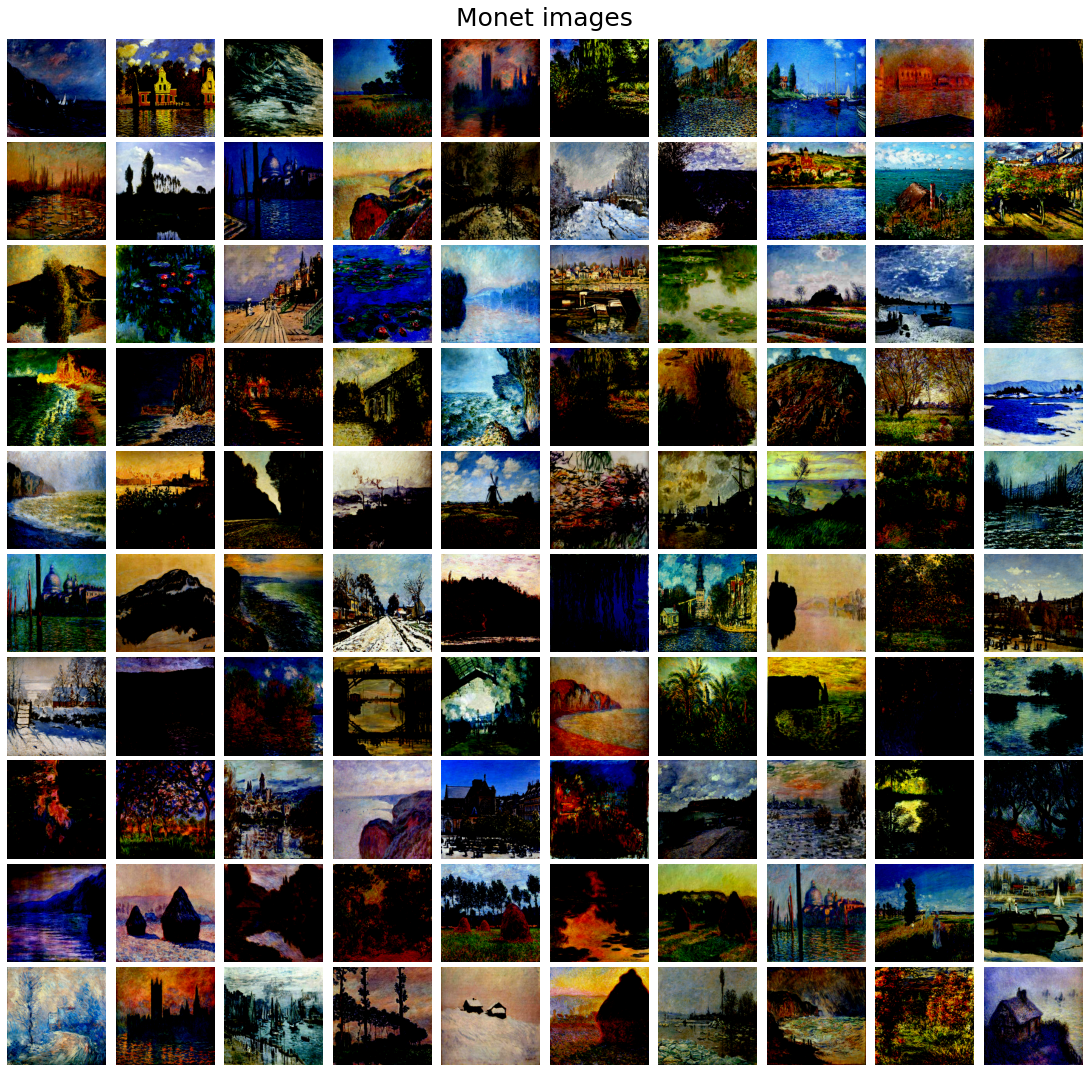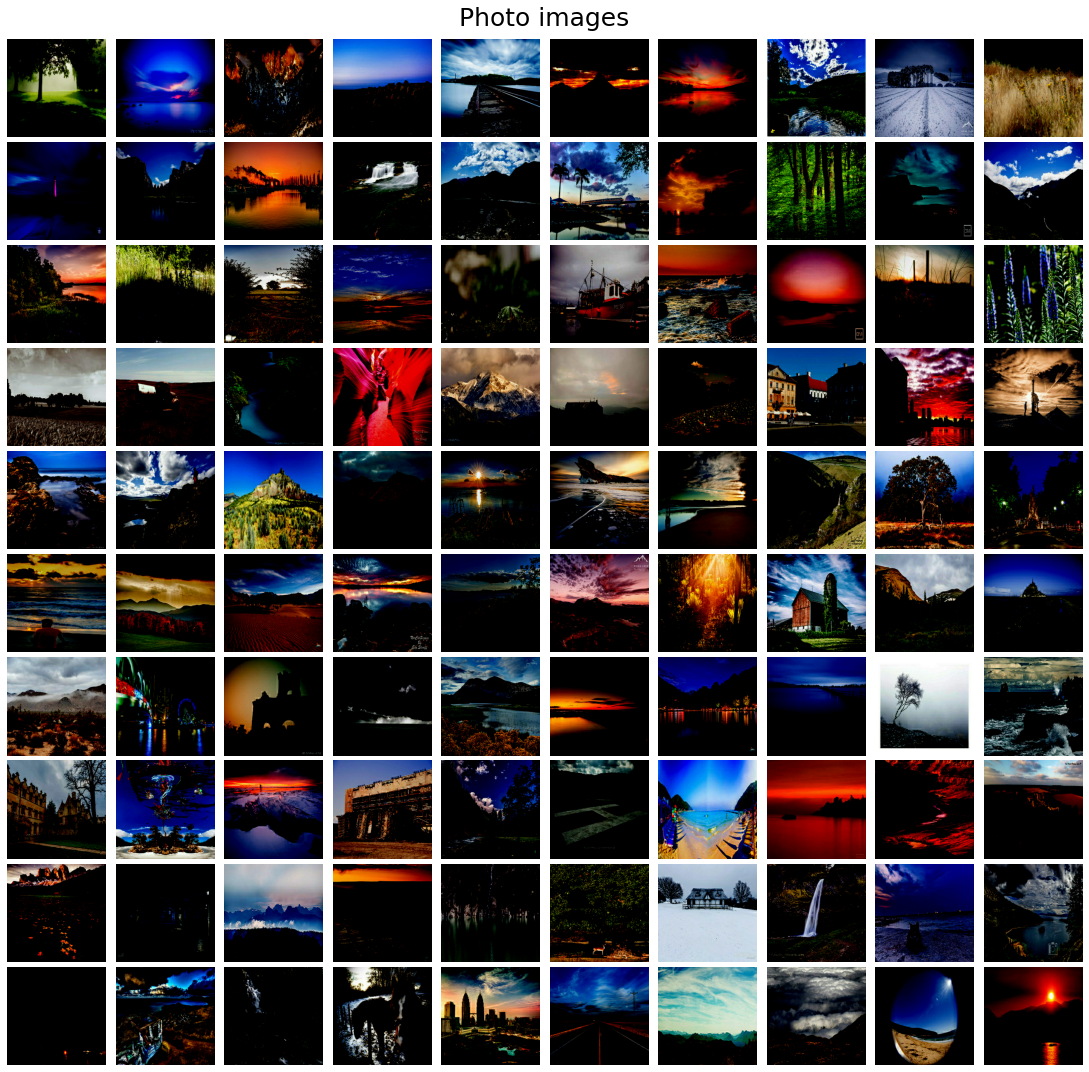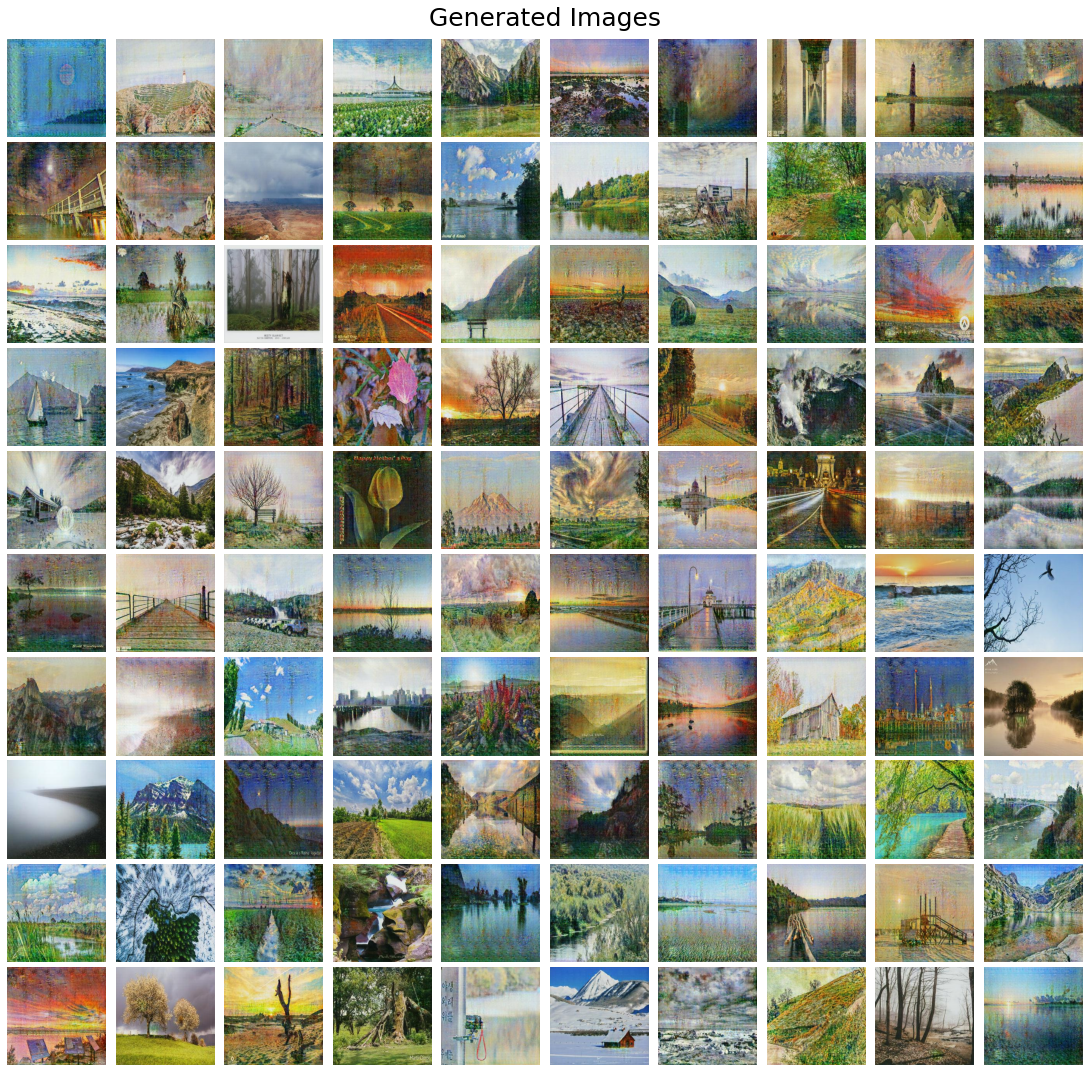This problem appeared as a project in the coursera course Deep Learning (by the University of Colorado Boulder) and also appeared in a Kaggle Competition.
Brief description of the problem and data
In this project, the goal is to build a GAN that generates 7,000 to 10,000 Monet-style images.
Computer vision has advanced tremendously in recent years and GANs are now capable of mimicking objects in a very convincing way. But creating museum-worthy masterpieces is thought of to be, well, more art than science. So can (data) science, in the form of GANs, trick classifiers into believing that we have created a true Monet? That’s the challenge we shall take on!
A GAN consists of at least two neural networks: a generator model and a discriminator model. The generator is a neural network that creates the images. For our competition, you should generate images in the style of Monet. This generator is trained using a discriminator.
The two models will work against each other, with the generator trying to trick the discriminator, and the discriminator trying to accurately classify the real vs. generated images.
Exploratory Data Analysis (EDA)
In this project we are going to use CycleGAN for style transfer. First we need to import all python packages / functions that are required (install the ones that are not already installed with pip) for building the GAN model. We shall use tensorflow / keras to train the generative model.
import numpy as np
import re, os, shutil
from glob import glob
import tqdm
import matplotlib.pylab as plt
# for building the model
import tensorflow as tf
import tensorflow.keras.backend as K
#! pip install tensorflow_addons
import tensorflow_addons as tfa
import tensorflow_datasets as tfds
from tensorflow import keras
from tensorflow.keras import layers, losses
Let’s read the tfrecords and create a tensorflow ZipDataset by combining the photo and monte style images. We can see that the number of monet style images (300) is much smaller than number of photo images (7038), so the images are not paired.
def load_dataset(filenames, labeled=True, ordered=False, autotune=tf.data.experimental.AUTOTUNE):
dataset = tf.data.TFRecordDataset(filenames)
dataset = dataset.map(read_tfrecord, num_parallel_calls=autotune)
return dataset
def decode_image(image, img_size=[256,256,3]):
image = tf.image.decode_jpeg(image, channels=3)
image = (tf.cast(image, tf.float32) / 127.5) - 1
image = tf.reshape(image, img_size)
return image
def read_tfrecord(example):
tfrecord_format = {
"image_name": tf.io.FixedLenFeature([], tf.string),
"image": tf.io.FixedLenFeature([], tf.string),
"target": tf.io.FixedLenFeature([], tf.string)
}
example = tf.io.parse_single_example(example, tfrecord_format)
image = decode_image(example['image'])
return image
def count_data_items(filenames):
n = [int(re.compile(r"-([0-9]*)\.").search(filename).group(1)) for filename in filenames]
return np.sum(n)
data_path = 'gan-getting-started'
monet_filenames = tf.io.gfile.glob(str(os.path.join(data_path, 'monet_tfrec', '*.tfrec')))
photo_filenames = tf.io.gfile.glob(str(os.path.join(data_path, 'photo_tfrec', '*.tfrec')))
monet_ds = load_dataset(monet_filenames)
photo_ds = load_dataset(photo_filenames)
n_monet_samples = count_data_items(monet_filenames)
n_photo_samples = count_data_items(photo_filenames)
dataset = tf.data.Dataset.zip((monet_ds, photo_ds))
n_monet_samples, n_photo_samples
# (300, 7038)
Let’s plot a few sample images from monet style and photo images.
def plot_images(images, title):
plt.figure(figsize=(15,15))
plt.subplots_adjust(0,0,1,0.95,0.05,0.05)
j = 1
for i in np.random.choice(len(images), 100, replace=False):
plt.subplot(10,10,j), plt.imshow(images[i] / images[i].max()), plt.axis('off')
j += 1
plt.suptitle(title, size=25)
plt.show()
monet_numpy = list(monet_ds.as_numpy_iterator())
plot_images(monet_numpy, 'Monet images')
Monet Style input images

plot_images(list(photo_ds.as_numpy_iterator()), 'Photo images')
Photo input images

Preprocessing
As can be seen, the images are transformed to have values in between [-1,1], implemented with the function decode_image() above.
Model Architecture
Paired data is harder to find in most domains, and not even possible in some, the unsupervised training capabilities of CycleGAN are quite useful, it does not require paired training data (which we don’t have in this case, we have 300 monet images and ~7k photo images). Hence, the problem can be forumulated as unpaired image-to-image translation and CycleGAN is an ideal model to be used here. We shall train the CycleGAN model on the image dataset provided (to translate from photo to monet style images) and then use the Genrator to generate monet images later. The next figure shows the architecture and the next code snippet provides the implementation:

class CycleGAN(keras.Model):
def __init__(
self,
monet_generator,
photo_generator,
monet_discriminator,
photo_discriminator,
lambda_cycle=10,
):
super(CycleGAN, self).__init__()
self.m_gen = monet_generator
self.p_gen = photo_generator
self.m_disc = monet_discriminator
self.p_disc = photo_discriminator
self.lambda_cycle = lambda_cycle
def compile(
self,
m_gen_optimizer,
p_gen_optimizer,
m_disc_optimizer,
p_disc_optimizer,
gen_loss_fn,
disc_loss_fn,
cycle_loss_fn,
identity_loss_fn
):
super(CycleGAN, self).compile()
self.m_gen_optimizer = m_gen_optimizer
self.p_gen_optimizer = p_gen_optimizer
self.m_disc_optimizer = m_disc_optimizer
self.p_disc_optimizer = p_disc_optimizer
self.gen_loss_fn = gen_loss_fn
self.disc_loss_fn = disc_loss_fn
self.cycle_loss_fn = cycle_loss_fn
self.identity_loss_fn = identity_loss_fn
def generate(self, image):
return self.m_gen(tf.expand_dims(image, axis=0), training=False)
def load(
self,
filepath
):
self.m_gen.load_weights(filepath.replace('model_name', 'm_gen'), by_name=True)
self.p_gen.load_weights(filepath.replace('model_name', 'p_gen'), by_name=True)
self.m_disc.load_weights(filepath.replace('model_name', 'm_disc'), by_name=True)
self.p_disc.load_weights(filepath.replace('model_name', 'p_disc'), by_name=True)
def save(
self,
filepath
):
self.m_gen.save(filepath.replace('model_name', 'm_gen'))
self.p_gen.save(filepath.replace('model_name', 'p_gen'))
self.m_disc.save(filepath.replace('model_name', 'm_disc'))
self.p_disc.save(filepath.replace('model_name', 'p_disc'))
def train_step(self, batch_data):
real_monet, real_photo = batch_data
with tf.GradientTape(persistent=True) as tape:
# photo to monet back to photo
real_photo = tf.expand_dims(real_photo, axis=0)
real_monet = tf.expand_dims(real_monet, axis=0)
fake_monet = self.m_gen(real_photo, training=True)
cycled_photo = self.p_gen(fake_monet, training=True)
# monet to photo back to monet
fake_photo = self.p_gen(real_monet, training=True)
cycled_monet = self.m_gen(fake_photo, training=True)
# generating itself
same_monet = self.m_gen(real_monet, training=True)
same_photo = self.p_gen(real_photo, training=True)
# discriminator used to check, inputing real images
disc_real_monet = self.m_disc(real_monet, training=True)
disc_real_photo = self.p_disc(real_photo, training=True)
# discriminator used to check, inputing fake images
disc_fake_monet = self.m_disc(fake_monet, training=True)
disc_fake_photo = self.p_disc(fake_photo, training=True)
# evaluates generator loss
monet_gen_loss = self.gen_loss_fn(disc_fake_monet)
photo_gen_loss = self.gen_loss_fn(disc_fake_photo)
# evaluates total cycle consistency loss
total_cycle_loss = self.cycle_loss_fn(real_monet, cycled_monet, self.lambda_cycle) + self.cycle_loss_fn(real_photo, cycled_photo, self.lambda_cycle)
# evaluates total generator loss
total_monet_gen_loss = monet_gen_loss + total_cycle_loss + self.identity_loss_fn(real_monet, same_monet, self.lambda_cycle)
total_photo_gen_loss = photo_gen_loss + total_cycle_loss + self.identity_loss_fn(real_photo, same_photo, self.lambda_cycle)
# evaluates discriminator loss
monet_disc_loss = self.disc_loss_fn(disc_real_monet, disc_fake_monet)
photo_disc_loss = self.disc_loss_fn(disc_real_photo, disc_fake_photo)
# Calculate the gradients for generator and discriminator
monet_generator_gradients = tape.gradient(total_monet_gen_loss, self.m_gen.trainable_variables)
photo_generator_gradients = tape.gradient(total_photo_gen_loss, self.p_gen.trainable_variables)
monet_discriminator_gradients = tape.gradient(monet_disc_loss, self.m_disc.trainable_variables)
photo_discriminator_gradients = tape.gradient(photo_disc_loss, self.p_disc.trainable_variables)
# Apply the gradients to the optimizer
self.m_gen_optimizer.apply_gradients(zip(monet_generator_gradients, self.m_gen.trainable_variables))
self.p_gen_optimizer.apply_gradients(zip(photo_generator_gradients, self.p_gen.trainable_variables))
self.m_disc_optimizer.apply_gradients(zip(monet_discriminator_gradients, self.m_disc.trainable_variables))
self.p_disc_optimizer.apply_gradients(zip(photo_discriminator_gradients, self.p_disc.trainable_variables))
total_loss = total_monet_gen_loss + total_photo_gen_loss + monet_disc_loss + photo_disc_loss
return {
"total_loss": total_loss,
"monet_gen_loss": total_monet_gen_loss,
"photo_gen_loss": total_photo_gen_loss,
"monet_disc_loss": monet_disc_loss,
"photo_disc_loss": photo_disc_loss
}
The CycleGAN is an extension of the GAN architecture that involves the simultaneous training of two generator models and two discriminator models. The CycleGAN uses an additional extension to the architecture called cycle consistency. This is the idea that an image output by the first generator could be used as input to the second generator and the output of the second generator should match the original image.
The Discriminator is a deep convolutional neural network that performs image classification. It takes a source image as input and predicts the likelihood of whether the target image is a real or fake image. Two discriminator models are used, one for Domain-A (photos) and one for Domain-B (monets).

The generator is an encoder-decoder model architecture. The discriminator models are trained directly on real and generated images, whereas the generator models are not. The model takes a source image (e.g. a photo) and generates a target image (e.g. a monet image). It does this by first downsampling or encoding the input image down to a bottleneck layer, then interpreting the encoding with a number of ResNet layers that use skip connections, followed by a series of layers that upsample or decode the representation to the size of the output image.

def Generator(img_shape=[256, 256, 3]):
inputs = layers.Input(shape=img_shape)
down_stack = [
downsample(64, 4, apply_instancenorm=False),
downsample(128, 4),
downsample(256, 4),
downsample(512, 4),
downsample(512, 4),
downsample(512, 4),
downsample(512, 4),
downsample(512, 4),
]
up_stack = [
upsample(512, 4, apply_dropout=True),
upsample(512, 4, apply_dropout=True),
upsample(512, 4, apply_dropout=True),
upsample(512, 4),
upsample(256, 4),
upsample(128, 4),
upsample(64, 4),
]
initializer = tf.random_normal_initializer(0., 0.02)
last = layers.Conv2DTranspose(3, 4, strides=2, padding='same', kernel_initializer=initializer, activation='tanh')
x = inputs
skips = []
for down in down_stack:
x = down(x)
skips.append(x)
skips = reversed(skips[:-1])
for up, skip in zip(up_stack, skips):
x = up(x)
x = layers.Concatenate()([x, skip])
x = last(x)
return keras.Model(inputs=inputs, outputs=x)
def Discriminator(img_shape=[256, 256, 3]):
initializer = tf.random_normal_initializer(0., 0.02)
gamma_init = keras.initializers.RandomNormal(mean=0.0, stddev=0.02)
inp = layers.Input(shape=img_shape, name='input_image')
x = inp
x = downsample(64, 4, False)(x)
x = downsample(128, 4)(x)
x = downsample(256, 4)(x)
x = layers.ZeroPadding2D()(x)
x = layers.Conv2D(512, 4, strides=1, kernel_initializer=initializer, use_bias=False)(x)
x = tfa.layers.InstanceNormalization(gamma_initializer=gamma_init)(x)
x = layers.LeakyReLU()(x)
x = layers.ZeroPadding2D()(x)
x = layers.Conv2D(1, 4, strides=1, kernel_initializer=initializer)(x)
return tf.keras.Model(inputs=inp, outputs=x)
def downsample(filters, size, apply_instancenorm=True):
initializer = tf.random_normal_initializer(0., 0.02)
gamma_init = keras.initializers.RandomNormal(mean=0.0, stddev=0.02)
result = keras.Sequential()
result.add(layers.Conv2D(filters, size, strides=2, padding='same', kernel_initializer=initializer, use_bias=False))
if apply_instancenorm:
result.add(tfa.layers.InstanceNormalization(gamma_initializer=gamma_init))
result.add(layers.LeakyReLU())
return result
def upsample(filters, size, apply_dropout=False):
initializer = tf.random_normal_initializer(0., 0.02)
gamma_init = keras.initializers.RandomNormal(mean=0.0, stddev=0.02)
result = keras.Sequential()
result.add(layers.Conv2DTranspose(filters, size, strides=2, padding='same', kernel_initializer=initializer, use_bias=False))
result.add(tfa.layers.InstanceNormalization(gamma_initializer=gamma_init))
if apply_dropout:
result.add(layers.Dropout(0.5))
result.add(layers.ReLU())
return result
def discriminator_loss(real, generated):
real_loss = losses.BinaryCrossentropy(from_logits=True, reduction=losses.Reduction.NONE)(tf.ones_like(real), real)
generated_loss = losses.BinaryCrossentropy(from_logits=True, reduction=losses.Reduction.NONE)(tf.zeros_like(generated), generated)
total_disc_loss = real_loss + generated_loss
return total_disc_loss * 0.5
def generator_loss(generated):
return losses.BinaryCrossentropy(from_logits=True, reduction=losses.Reduction.NONE)(tf.ones_like(generated), generated)
def calc_cycle_loss(real_image, cycled_image, LAMBDA):
return LAMBDA * tf.reduce_mean(tf.abs(real_image - cycled_image))
def identity_loss(real_image, same_image, LAMBDA):
return LAMBDA * 0.5 * tf.reduce_mean(tf.abs(real_image - same_image))
img_shape = [256, 256, 3]
model = CycleGAN(
monet_generator=Generator(img_shape),
photo_generator=Generator(img_shape),
monet_discriminator=Discriminator(img_shape),
photo_discriminator=Discriminator(img_shape),
lambda_cycle=10
)
model.compile(
m_gen_optimizer=tf.keras.optimizers.Adam(1e-4, beta_1=0.5),
p_gen_optimizer=tf.keras.optimizers.Adam(1e-4, beta_1=0.5),
m_disc_optimizer=tf.keras.optimizers.Adam(1e-4, beta_1=0.5),
p_disc_optimizer=tf.keras.optimizers.Adam(1e-4, beta_1=0.5),
gen_loss_fn=generator_loss,
disc_loss_fn=discriminator_loss,
cycle_loss_fn=calc_cycle_loss,
identity_loss_fn=identity_loss
)
Results and Analysis
Let’s train the GAN model (both the generators and discriminators simultaneously) for 50 epochs.
# Train the model
batch_size = 32
#tf.config.run_functions_eagerly(True)
#tf.get_logger().setLevel('INFO')
epochs = 50
history = model.fit(dataset, epochs=epochs, batch_size=batch_size)
Epoch 1/50
2023-03-27 19:18:41.116027: E tensorflow/core/grappler/optimizers/meta_optimizer.cc:954] layout failed: INVALID_ARGUMENT: Size of values 0 does not match size of permutation 4 @ fanin shape inmodel/sequential_8/dropout/dropout_2/SelectV2-2-TransposeNHWCToNCHW-LayoutOptimizer
300/300 [==============================] - 178s 442ms/step - total_loss: 13.5143 - monet_gen_loss: 6.0788 - photo_gen_loss: 6.2427 - monet_disc_loss: 0.6130 - photo_disc_loss: 0.5799
Epoch 2/50
300/300 [==============================] - 132s 440ms/step - total_loss: 9.6236 - monet_gen_loss: 4.1237 - photo_gen_loss: 4.3565 - monet_disc_loss: 0.6405 - photo_disc_loss: 0.5029
Epoch 3/50
300/300 [==============================] - 132s 440ms/step - total_loss: 9.1091 - monet_gen_loss: 3.8061 - photo_gen_loss: 4.2105 - monet_disc_loss: 0.6381 - photo_disc_loss: 0.4545
Epoch 4/50
300/300 [==============================] - 132s 440ms/step - total_loss: 9.0574 - monet_gen_loss: 3.8176 - photo_gen_loss: 4.1377 - monet_disc_loss: 0.5952 - photo_disc_loss: 0.5070
Epoch 5/50
300/300 [==============================] - 132s 440ms/step - total_loss: 9.0721 - monet_gen_loss: 3.8688 - photo_gen_loss: 4.1645 - monet_disc_loss: 0.5462 - photo_disc_loss: 0.4925
Epoch 6/50
300/300 [==============================] - 132s 440ms/step - total_loss: 9.1115 - monet_gen_loss: 3.8860 - photo_gen_loss: 4.1123 - monet_disc_loss: 0.5778 - photo_disc_loss: 0.5354
Epoch 7/50
300/300 [==============================] - 132s 439ms/step - total_loss: 8.9233 - monet_gen_loss: 3.7933 - photo_gen_loss: 3.9551 - monet_disc_loss: 0.5987 - photo_disc_loss: 0.5761
Epoch 8/50
300/300 [==============================] - 132s 440ms/step - total_loss: 8.7080 - monet_gen_loss: 3.6934 - photo_gen_loss: 3.8289 - monet_disc_loss: 0.6077 - photo_disc_loss: 0.5780
Epoch 9/50
300/300 [==============================] - 132s 440ms/step - total_loss: 8.5513 - monet_gen_loss: 3.6243 - photo_gen_loss: 3.7549 - monet_disc_loss: 0.5994 - photo_disc_loss: 0.5727
Epoch 10/50
300/300 [==============================] - 132s 440ms/step - total_loss: 8.4467 - monet_gen_loss: 3.5701 - photo_gen_loss: 3.7059 - monet_disc_loss: 0.6021 - photo_disc_loss: 0.5686
Epoch 11/50
300/300 [==============================] - 132s 440ms/step - total_loss: 8.3335 - monet_gen_loss: 3.5100 - photo_gen_loss: 3.6443 - monet_disc_loss: 0.6047 - photo_disc_loss: 0.5744
Epoch 12/50
300/300 [==============================] - 132s 440ms/step - total_loss: 8.1454 - monet_gen_loss: 3.3979 - photo_gen_loss: 3.5508 - monet_disc_loss: 0.6197 - photo_disc_loss: 0.5770
Epoch 13/50
300/300 [==============================] - 132s 440ms/step - total_loss: 7.9934 - monet_gen_loss: 3.3216 - photo_gen_loss: 3.4639 - monet_disc_loss: 0.6189 - photo_disc_loss: 0.5889
Epoch 14/50
300/300 [==============================] - 132s 440ms/step - total_loss: 7.8940 - monet_gen_loss: 3.2744 - photo_gen_loss: 3.4177 - monet_disc_loss: 0.6144 - photo_disc_loss: 0.5875
Epoch 15/50
300/300 [==============================] - 132s 440ms/step - total_loss: 7.8149 - monet_gen_loss: 3.2327 - photo_gen_loss: 3.3816 - monet_disc_loss: 0.6144 - photo_disc_loss: 0.5862
Epoch 16/50
300/300 [==============================] - 132s 440ms/step - total_loss: 7.7611 - monet_gen_loss: 3.2000 - photo_gen_loss: 3.3537 - monet_disc_loss: 0.6176 - photo_disc_loss: 0.5898
Epoch 17/50
300/300 [==============================] - 132s 440ms/step - total_loss: 7.7349 - monet_gen_loss: 3.1919 - photo_gen_loss: 3.3390 - monet_disc_loss: 0.6143 - photo_disc_loss: 0.5897
Epoch 18/50
300/300 [==============================] - 132s 439ms/step - total_loss: 7.6678 - monet_gen_loss: 3.1610 - photo_gen_loss: 3.2970 - monet_disc_loss: 0.6160 - photo_disc_loss: 0.5938
Epoch 19/50
300/300 [==============================] - 132s 440ms/step - total_loss: 7.6531 - monet_gen_loss: 3.1560 - photo_gen_loss: 3.2872 - monet_disc_loss: 0.6158 - photo_disc_loss: 0.5941
Epoch 20/50
300/300 [==============================] - 132s 440ms/step - total_loss: 7.5918 - monet_gen_loss: 3.1216 - photo_gen_loss: 3.2546 - monet_disc_loss: 0.6182 - photo_disc_loss: 0.5974
Epoch 21/50
300/300 [==============================] - 132s 439ms/step - total_loss: 7.5678 - monet_gen_loss: 3.1125 - photo_gen_loss: 3.2480 - monet_disc_loss: 0.6141 - photo_disc_loss: 0.5932
Epoch 22/50
300/300 [==============================] - 132s 439ms/step - total_loss: 7.5094 - monet_gen_loss: 3.0878 - photo_gen_loss: 3.2083 - monet_disc_loss: 0.6158 - photo_disc_loss: 0.5975
Epoch 23/50
300/300 [==============================] - 132s 439ms/step - total_loss: 7.5019 - monet_gen_loss: 3.0877 - photo_gen_loss: 3.2045 - monet_disc_loss: 0.6138 - photo_disc_loss: 0.5958
Epoch 24/50
300/300 [==============================] - 132s 440ms/step - total_loss: 7.4443 - monet_gen_loss: 3.0563 - photo_gen_loss: 3.1699 - monet_disc_loss: 0.6180 - photo_disc_loss: 0.6001
Epoch 25/50
300/300 [==============================] - 132s 439ms/step - total_loss: 7.4156 - monet_gen_loss: 3.0429 - photo_gen_loss: 3.1655 - monet_disc_loss: 0.6165 - photo_disc_loss: 0.5907
Epoch 26/50
300/300 [==============================] - 132s 440ms/step - total_loss: 7.3863 - monet_gen_loss: 3.0236 - photo_gen_loss: 3.1437 - monet_disc_loss: 0.6213 - photo_disc_loss: 0.5977
Epoch 27/50
300/300 [==============================] - 132s 440ms/step - total_loss: 7.3447 - monet_gen_loss: 3.0054 - photo_gen_loss: 3.1185 - monet_disc_loss: 0.6231 - photo_disc_loss: 0.5977
Epoch 28/50
300/300 [==============================] - 132s 440ms/step - total_loss: 7.3085 - monet_gen_loss: 2.9852 - photo_gen_loss: 3.0985 - monet_disc_loss: 0.6254 - photo_disc_loss: 0.5994
Epoch 29/50
300/300 [==============================] - 132s 440ms/step - total_loss: 7.2748 - monet_gen_loss: 2.9651 - photo_gen_loss: 3.0832 - monet_disc_loss: 0.6306 - photo_disc_loss: 0.5960
Epoch 30/50
300/300 [==============================] - 132s 440ms/step - total_loss: 7.2610 - monet_gen_loss: 2.9589 - photo_gen_loss: 3.0837 - monet_disc_loss: 0.6276 - photo_disc_loss: 0.5908
Epoch 31/50
300/300 [==============================] - 132s 440ms/step - total_loss: 7.1940 - monet_gen_loss: 2.9234 - photo_gen_loss: 3.0399 - monet_disc_loss: 0.6340 - photo_disc_loss: 0.5967
Epoch 32/50
300/300 [==============================] - 132s 440ms/step - total_loss: 7.1518 - monet_gen_loss: 2.9051 - photo_gen_loss: 3.0160 - monet_disc_loss: 0.6356 - photo_disc_loss: 0.5952
Epoch 33/50
300/300 [==============================] - 132s 439ms/step - total_loss: 7.1283 - monet_gen_loss: 2.8942 - photo_gen_loss: 3.0005 - monet_disc_loss: 0.6368 - photo_disc_loss: 0.5969
Epoch 34/50
300/300 [==============================] - 132s 439ms/step - total_loss: 7.0966 - monet_gen_loss: 2.8813 - photo_gen_loss: 2.9824 - monet_disc_loss: 0.6379 - photo_disc_loss: 0.5950
Epoch 35/50
300/300 [==============================] - 132s 439ms/step - total_loss: 7.0460 - monet_gen_loss: 2.8441 - photo_gen_loss: 2.9676 - monet_disc_loss: 0.6409 - photo_disc_loss: 0.5934
Epoch 36/50
300/300 [==============================] - 132s 439ms/step - total_loss: 6.9889 - monet_gen_loss: 2.8174 - photo_gen_loss: 2.9290 - monet_disc_loss: 0.6417 - photo_disc_loss: 0.6008
Epoch 37/50
300/300 [==============================] - 132s 439ms/step - total_loss: 6.9392 - monet_gen_loss: 2.7863 - photo_gen_loss: 2.9042 - monet_disc_loss: 0.6431 - photo_disc_loss: 0.6055
Epoch 38/50
300/300 [==============================] - 132s 440ms/step - total_loss: 6.9482 - monet_gen_loss: 2.8005 - photo_gen_loss: 2.9125 - monet_disc_loss: 0.6349 - photo_disc_loss: 0.6004
Epoch 39/50
300/300 [==============================] - 132s 440ms/step - total_loss: 6.9012 - monet_gen_loss: 2.7681 - photo_gen_loss: 2.8925 - monet_disc_loss: 0.6363 - photo_disc_loss: 0.6043
Epoch 40/50
300/300 [==============================] - 132s 440ms/step - total_loss: 6.7845 - monet_gen_loss: 2.7000 - photo_gen_loss: 2.8238 - monet_disc_loss: 0.6453 - photo_disc_loss: 0.6154
Epoch 41/50
300/300 [==============================] - 132s 440ms/step - total_loss: 6.7913 - monet_gen_loss: 2.6840 - photo_gen_loss: 2.8536 - monet_disc_loss: 0.6443 - photo_disc_loss: 0.6094
Epoch 42/50
300/300 [==============================] - 132s 440ms/step - total_loss: 6.6722 - monet_gen_loss: 2.6384 - photo_gen_loss: 2.7718 - monet_disc_loss: 0.6458 - photo_disc_loss: 0.6163
Epoch 43/50
300/300 [==============================] - 132s 440ms/step - total_loss: 6.7128 - monet_gen_loss: 2.6721 - photo_gen_loss: 2.7917 - monet_disc_loss: 0.6393 - photo_disc_loss: 0.6097
Epoch 44/50
300/300 [==============================] - 132s 439ms/step - total_loss: 6.6979 - monet_gen_loss: 2.6490 - photo_gen_loss: 2.8041 - monet_disc_loss: 0.6406 - photo_disc_loss: 0.6041
Epoch 45/50
300/300 [==============================] - 132s 439ms/step - total_loss: 6.9362 - monet_gen_loss: 2.8560 - photo_gen_loss: 2.9042 - monet_disc_loss: 0.5885 - photo_disc_loss: 0.5875
Epoch 46/50
300/300 [==============================] - 132s 439ms/step - total_loss: 6.8214 - monet_gen_loss: 2.7380 - photo_gen_loss: 2.8306 - monet_disc_loss: 0.6469 - photo_disc_loss: 0.6059
Epoch 47/50
300/300 [==============================] - 132s 440ms/step - total_loss: 6.6745 - monet_gen_loss: 2.6516 - photo_gen_loss: 2.7894 - monet_disc_loss: 0.6332 - photo_disc_loss: 0.6002
Epoch 48/50
300/300 [==============================] - 132s 439ms/step - total_loss: 6.7603 - monet_gen_loss: 2.7036 - photo_gen_loss: 2.8374 - monet_disc_loss: 0.6253 - photo_disc_loss: 0.5939
Epoch 49/50
300/300 [==============================] - 132s 440ms/step - total_loss: 6.8899 - monet_gen_loss: 2.8052 - photo_gen_loss: 2.9074 - monet_disc_loss: 0.6024 - photo_disc_loss: 0.5748
Epoch 50/50
300/300 [==============================] - 132s 439ms/step - total_loss: 6.7139 - monet_gen_loss: 2.6874 - photo_gen_loss: 2.8110 - monet_disc_loss: 0.6241 - photo_disc_loss: 0.5913
Let’s save the model.
model.save('cyclegan_100.h5')
Let’s plot the loss for the generators and discriminators, for generators we plot the mean loss.
history.history.keys()
# dict_keys(['total_loss', 'monet_gen_loss', 'photo_gen_loss', 'monet_disc_loss', 'photo_disc_loss'])
def plot_hist(hist):
plt.figure(figsize=(10,5))
plt.subplot(121)
#plt.plot(np.mean(hist.history['monet_gen_loss'][0][0], axis=1))
#plt.plot(np.mean(hist.history['photo_gen_loss'][0][0], axis=1))
plt.plot(hist.history['monet_gen_loss'][0][0].flatten())
plt.plot(hist.history['photo_gen_loss'][0][0].flatten())
plt.legend(["monet","photo"])
plt.title('Generator Loss')
plt.ylabel("Loss")
plt.xlabel("Epoch")
plt.grid()
plt.subplot(122)
plt.plot(hist.history['monet_disc_loss'][0][0].flatten())
plt.plot(hist.history['photo_disc_loss'][0][0].flatten())
plt.title("Discriminator Loss")
plt.ylabel("Loss")
plt.xlabel("Epoch")
plt.grid()
plt.legend(["monet","photo"])
plt.tight_layout()
plt.show()
plot_hist(history)

Finally, let’s use the generated to generate ~7k images and save / submit the notebook to kaggle.
! mkdir ../images
def generate(dataset):
dataset_iter = iter(dataset)
out_dir = '../images/'
for i in tqdm.tqdm(range(n_photo_samples)):
# Get the image from the dataset iterator
img = next(dataset_iter)
prediction = model.generate(img)
prediction = tf.squeeze(prediction).numpy()
prediction = (prediction * 127.5 + 127.5).astype(np.uint8)
plt.imsave(os.path.join(out_dir, 'image_{:04d}.jpg'.format(i)), prediction)
generate(photo_ds)
shutil.make_archive("/kaggle/working/images", 'zip', "/kaggle/images")
The next figure shows few of the images generated.
plot_images([plt.imread(f) for f in glob('out/*.jpg')[:200]], 'Generated Images')


Git Repository
https://github.com/sandipan/Monet-Style-Transfer-with-GANs-Kaggle-Mini-Project
Kaggle Notebook
https://www.kaggle.com/code/sandipanumbc/monet-style-transfer-with-cyclegan
Conclusion
As we can see from the above results, the CycleGAN does a pretty good job in generating the monet-style images from photos. The model was trained for 50 epochs, it seems that losses will decrease further if increased for more epochs (e.g., 100), we can get a better model.
Kaggle uses an evaluation metric called MiFID (Memorization-informed Fréchet Inception Distance) score to evaluate the quality of generated images. The score obtained on Kaggle is ~54.18 and the leaderboard position is 49, as shown in the following screenshots.

